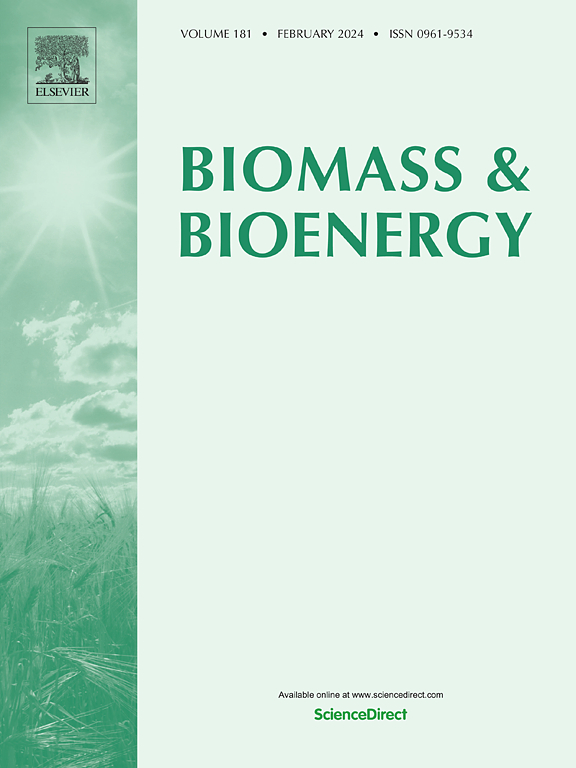Steam-oxygen blown circulating fluidised bed gasification for synthetic biofuel production: Pilot-scale reactor modelling, model-based reactor scale-up and analysis for power-biomass-to-liquid processes
IF 5.8
2区 生物学
Q1 AGRICULTURAL ENGINEERING
引用次数: 0
Abstract
Steam-oxygen blown gasification is a prominent gasification technology for producing synthetic biofuels and biochemicals from biomass. A 1.5D semi-empirical model is developed for circulating fluidised bed gasification. The model is validated using data from 500 kW pilot gasifier tests reported in the literature. The validated model is used in designing a 100 MW scale gasifier concept. The model is used to investigate the effect of the operating temperature and steam-to-biomass (S/B) ratio on the performance and producer gas composition of the large-scale gasifier. The validation study showed the model to predict producer gas composition accurately. The estimate was within +−15% for the main gas species. The parametric study illustrated producer gas composition to be more sensitive to the S/B ratio than operating temperature. The ratio can be achieved when an electrolyser is used to satisfy the oxygen consumption of the large-scale gasifier, and the obtained hydrogen side stream is mixed with syngas downstream of the gasifier. The large-scale simulation results are compared to literature data from different gasifiers. The comparison shows that the influence of the investigated parameters is small relative to the scattering of the data. The phenomena affecting the gas composition and performance of the gasifier are discussed. The findings of the study contribute to an understanding of the physical operation of the gasification process. The study presents the mass and energy balances of the large-scale scale gasifier, which can be used in conceptual studies of synthetic biofuel and chemical production.
用于合成生物燃料生产的蒸汽氧吹循环流化床气化:中试规模反应器建模,基于模型的反应器放大和动力-生物质-液体工艺分析
蒸汽氧吹气化是一种重要的气化技术,用于从生物质中生产合成生物燃料和生化物质。建立了循环流化床气化过程的1.5D半经验模型。该模型使用文献中报道的500千瓦中试气化炉试验数据进行验证。将该模型应用于100mw规模气化炉概念设计。利用该模型研究了操作温度和蒸汽与生物质(S/B)比对大型气化炉性能和产气组成的影响。验证研究表明,该模型能准确预测产气成分。对主要气体种类的估计在+ - 15%以内。参数化研究表明,产气组分对S/B比的敏感性大于操作温度。采用电解槽满足大型气化炉的耗氧量,得到的氢气侧流与气化炉下游的合成气混合,可以达到H2/CO=2的比例。将大规模模拟结果与不同气化炉的文献数据进行了比较。对比表明,所研究的参数对数据散射的影响较小。讨论了影响气化炉气体组成和性能的现象。研究结果有助于理解气化过程的物理操作。该研究展示了大型气化炉的质量和能量平衡,可用于合成生物燃料和化学生产的概念研究。
本文章由计算机程序翻译,如有差异,请以英文原文为准。
求助全文
约1分钟内获得全文
求助全文
来源期刊

Biomass & Bioenergy
工程技术-能源与燃料
CiteScore
11.50
自引率
3.30%
发文量
258
审稿时长
60 days
期刊介绍:
Biomass & Bioenergy is an international journal publishing original research papers and short communications, review articles and case studies on biological resources, chemical and biological processes, and biomass products for new renewable sources of energy and materials.
The scope of the journal extends to the environmental, management and economic aspects of biomass and bioenergy.
Key areas covered by the journal:
• Biomass: sources, energy crop production processes, genetic improvements, composition. Please note that research on these biomass subjects must be linked directly to bioenergy generation.
• Biological Residues: residues/rests from agricultural production, forestry and plantations (palm, sugar etc), processing industries, and municipal sources (MSW). Papers on the use of biomass residues through innovative processes/technological novelty and/or consideration of feedstock/system sustainability (or unsustainability) are welcomed. However waste treatment processes and pollution control or mitigation which are only tangentially related to bioenergy are not in the scope of the journal, as they are more suited to publications in the environmental arena. Papers that describe conventional waste streams (ie well described in existing literature) that do not empirically address ''new'' added value from the process are not suitable for submission to the journal.
• Bioenergy Processes: fermentations, thermochemical conversions, liquid and gaseous fuels, and petrochemical substitutes
• Bioenergy Utilization: direct combustion, gasification, electricity production, chemical processes, and by-product remediation
• Biomass and the Environment: carbon cycle, the net energy efficiency of bioenergy systems, assessment of sustainability, and biodiversity issues.
 求助内容:
求助内容: 应助结果提醒方式:
应助结果提醒方式:


